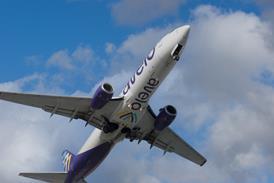The Federal Aviation Administration (FAA) has ordered Boeing to halt further 737 Max production rate increases as the agency undertakes a large-scale investigation intended to ensure the safety of the aircraft’s production system.
“The FAA today informed Boeing it will not grant any production expansion of the Max, including the 737-9 Max. This action comes on top of the FAA’s investigation and ramped up oversight of Boeing and its suppliers,” the agency said on 24 January.
The move is the agency’s latest response to the 5 January in-flight failure of a mid-cabin emergency exit door plug on an Alaska Airlines 737 Max 9.
The incident is under investigation by the FAA and the National Transportation Safety Board. Aviation experts suspect the failure resulted from a production quality problem – a theory supported by a 24 January report from The Seattle Times.
That report cited unnamed sources within Boeing saying that company records show that workers failed to properly secure the plug.
Boeing had most recently said it was producing 737s at a rate of 31 monthly, though that pace had been unsteady amid various quality and supply chain challenges. It is unclear the rate at which Boeing will be limited by the FAA’s action.

The company has said it aimed to be producing 50 737s monthly in 2025 or 2026.
“This won’t be back to business as usual for Boeing,” says FAA administrator Mike Whitaker. “We will not agree to any request from Boeing for an expansion in production or approve additional production lines for the 737 Max until we are satisfied that the quality control issues uncovered during this process are resolved.”
Boeing did not immediately respond to a request for comment.
The FAA is “scrutinising Boeing’s compliance with manufacturing requirements” and “aggressively expanding oversight of new aircraft, with increased floor presence at all Boeing facilities”, the agency adds. “The Jan 5 Boeing 737-9 Max incident must never happen again. Accordingly, the FAA is announcing additional actions to ensure every aircraft is safe.”
The 5 January incident left a gaping hole in the side of the Alaska 737 Max 9. The pilots landed safely without serious injuries to passengers or crew.
The FAA has since mandated that airlines inspect 737 Max 9 door plugs and related hardware, and re-torque fasteners.


























